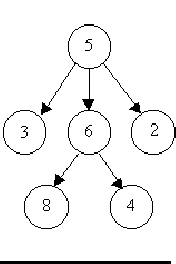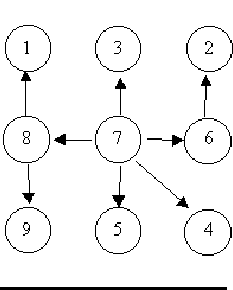Is It A Tree?
Time Limit: 2000/1000 MS (Java/Others) Memory Limit: 65536/32768 K (Java/Others)
Total Submission(s): 19907 Accepted Submission(s): 4472
Problem Description
A
tree is a well-known data structure that is either empty (null, void,
nothing) or is a set of one or more nodes connected by directed edges
between nodes satisfying the following properties.
There is exactly one node, called the root, to which no directed edges point.
Every node except the root has exactly one edge pointing to it.
There is a unique sequence of directed edges from the root to each node.
For example, consider the illustrations below, in which nodes are represented by circles and edges are represented by lines with arrowheads. The first two of these are trees, but the last is not.



In this problem you will be given several descriptions of collections of nodes connected by directed edges. For each of these you are to determine if the collection satisfies the definition of a tree or not.
There is exactly one node, called the root, to which no directed edges point.
Every node except the root has exactly one edge pointing to it.
There is a unique sequence of directed edges from the root to each node.
For example, consider the illustrations below, in which nodes are represented by circles and edges are represented by lines with arrowheads. The first two of these are trees, but the last is not.



In this problem you will be given several descriptions of collections of nodes connected by directed edges. For each of these you are to determine if the collection satisfies the definition of a tree or not.
Input
The
input will consist of a sequence of descriptions (test cases) followed
by a pair of negative integers. Each test case will consist of a
sequence of edge descriptions followed by a pair of zeroes Each edge
description will consist of a pair of integers; the first integer
identifies the node from which the edge begins, and the second integer
identifies the node to which the edge is directed. Node numbers will
always be greater than zero.
Output
For
each test case display the line ``Case k is a tree." or the line ``Case
k is not a tree.", where k corresponds to the test case number (they
are sequentially numbered starting with 1).
Sample Input
6 8 5 3 5 2 6 4
5 6 0 0
8 1 7 3 6 2 8 9 7 5
7 4 7 8 7 6 0 0
3 8 6 8 6 4
5 3 5 6 5 2 0 0
-1 -1
Sample Output
Case 1 is a tree.
Case 2 is a tree.
Case 3 is not a tree.
Source
判断有向图是否为树:
1,每个点的入度都不大于一
2,已经标记的点树根是自己的数量只能等于1,不然就是森林
3,不能成环
4,0 0也是树
package 并查集; import java.util.Scanner; public class hdu_1325 { static int [] father; static int [] indegree; static boolean [] flag; public static void main(String[] args) { Scanner sc = new Scanner(System.in); int k = 1; while(true){ boolean istree=true; father = new int [1000]; indegree = new int [1000]; flag = new boolean [1000]; int x = sc.nextInt(); int y =sc.nextInt(); if(x<0&&y<0) break; if(x==0&&y==0){ //空树也是树 System.out.println("Case "+(k++)+" is a tree."); continue; } for(int i=1;i<1000;i++){ father[i] = i; } while(true){ if(x==0&&y==0) break; int a = find(x); int b = find(y); flag[x] = true; flag[y] = true; if(a!=b) { father[a] = b; indegree[y]++; //入度加一 } if(a==b) istree = false; //成环 x = sc.nextInt(); y = sc.nextInt(); } int ans = 0; for(int i=1;i<1000;i++){ if(indegree[i]>1) { istree = false; //度大于一 } if(flag[i]&&father[i]==i) ans++; //这个点被标记过了并且自己还是一棵树的根 if(ans>1) istree = false; //森林 } if(istree) System.out.println("Case "+(k++)+" is a tree."); else System.out.println("Case "+(k++)+" is not a tree."); } } private static int find(int x) { if(x==father[x]) return x; return find(father[x]); } }